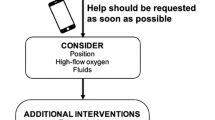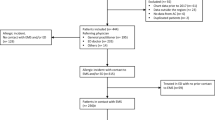Abstract
Background:
Anaphylaxis is an acute-onset, life-threatening, systemic hypersensitivity reaction. The acute reaction occurs due to a permanently immunologically altered response, which can result in mild to severe reactions and, in isolated cases, to fatal reactions upon allergen contact. The avoidance strategies required lifelong in affected individuals significantly impair quality of life.
Objective and methods:
An expert analysis of the supportive care situation of anaphylaxis patients.
Results:
The trigger of the reaction — mostly food, insect venom, or drugs — can normally be identified by means of allergy diagnostics. However, allergy workups unfortunately are not always performed in anaphylaxis patients. Unequivocal diagnosis and/or causal classification of the trigger is not always easy, particularly in the presence of summation factors, such as physical exertion or the use of analgesics or alcohol. Complex cases present too rarely in allergy centers with appropriate experience. Following anaphylaxis patients are given guidance on allergen avoidance and after obligatory instruction from a medical expert, receive a prescription for an emergency self-medication kit. However, studies show that allergen avoidance often fails and patient self-medication is frequently not performed. Therefore, the German working group on anaphylaxis training and education (Arbeitsgemeinschaft Anaphylaxie Training und Education, AGATE) formulated a structured written interdisciplinary educational training program that is currently used in 24 registered centers in Germany. In a multicenter study using control groups, the anaphylaxis training program showed significant efficacy in terms of practical emergency management and reduced anxiety. The nationwide implementation of the training program and cost-coverage by statutory health insurances appear reasonable given the potentially life-threatening nature of this disease. Since statutory health insurances have not guaranteed cost-coverage to date, it is not possible to offer the training program to all patients in need.
Conclusion:
Subject to region and center, there are good treatment options for anaphylaxis patients in Germany. However, these options are not always sufficiently implemented.


Similar content being viewed by others
References
Muraro A, Roberts G, Worm M, Bilò MB, Brockow K, Fernández Rivas M et al. Anaphylaxis: guidelines from the European Academy of Allergy and Clinical Immunology. Allergy 2014;69:1026–45
Ring J, Beyer K, Biedermann T, Bircher A, Duda D, Fischer J et al. Guideline for acute therapy und management of anaphylaxis. S2 guideline of DGAKI, AeDA, GPA, DAAU, BVKJ, ÖGAI, SGAI, DGAI, DGP, DGPM, AGATE and DAAB. Allergo J Int 2014;23:96–112
Sampson HA, Muñoz-Furlong A, Campbell RL, Adkinson NF Jr, Bock SA, Branum A et al. Second symposium on the definition and management of anaphylaxis: summary report — second National Institute of Allergy and Infectious Disease/Food Allergy and Anaphylaxis Network symposium. J Allergy Clin Immunol 2006;117:391–7
Morawetz DY, Hiscock H, Allen KJ, Davies S, Danchin MH. Management of food allergy: a survey of Australian paediatricians. J Paediatr Child Health 2014;50:432–37
Brockow K, Przybilla B, Aberer W, Bircher AJ, Brehler R, Dickel H et al. Guideline for the diagnosis of drug hypersensitivity reactions: S2K-Guideline of the German Society for Allergology and Clinical Immunology (DGAKI) and the German Dermatological Society (DDG) in collaboration with the Association of German Allergologists (AeDA), the German Society for Pediatric Allergology and Environmental Medicine (GPA), the German Contact Dermatitis Research Group (DKG), the Swiss Society for Allergy and Immunology (SGAI), the Austrian Society for Allergology and Immunology (OGAI), the German Academy of Allergology and Environmental Medicine (DAAU), the German Center for Documentation of Severe Skin Reactions and the German Federal Institute for Drugs and Medical Products (BfArM). Allergo J Int 2015;24:94–105
Przybilla B, Ruëff F, Walker A, Räwer H-C, Aberer W, Bauer CP et al. Diagnose und Therapie der Bienen- und Wespengiftallergie. Allergo Journal 2011;20:318–39
Worm M, Reese I, Ballmer-Weber B, Beyer K, Bischoff SC, Claßen M et al. Guidelines on the management of IgE-mediated food allergies: S2k-Guidelines of the German Society for Allergology and Clinical Immunology (DGAKI) in collaboration with the German Medical Association of Allergologists (AeDA), the German Professional Association of Pediatricians (BVKJ), the German Allergy and Asthma Association (DAAB), German Dermatological Society (DDG), the German Society for Nutrition (DGE), the German Society for Gastroenterology, Digestive and Metabolic Diseases (DGVS), the German Society for Oto-Rhino-Laryngology, Head and Neck Surgery, the German Society for Pediatric and Adolescent Medicine (DGKJ), the German Society for Pediatric Allergology and Environmental Medicine (GPA), the German Society for Pneumology (DGP), the German Society for Pediatric Gastroenterology and Nutrition (GPGE), German Contact Allergy Group (DKG), the Austrian Society for Allergology and Immunology (AE-GAI), German Professional Association of Nutritional Sciences (VDOE) and the Association of the Scientific Medical Societies Germany (AWMF). Allergo J Int 2015;24:256–93
Brockow K, Jofer C, Behrendt H, Ring J. Anaphylaxis in patients with mastocytosis: a study on history, clinical features and risk factors in 120 patients. Allergy 2008;63:226–32
Brockow K, Kneissl D, Valentini L, Zelger O, Grosber M, Kugler C et al. Using a gluten oral food challenge protocol to improve diagnosis of wheat-dependent exercise-induced anaphylaxis. J Allergy Clin Immunol 2015;135:977–84
Wehrmann W. Versorgungsstrukturen. In: Ring J, Bachert C, Bauer C, Czech W, eds. Weißbuch Allergie in Deutschland. 3. Auflage. Berlin — Heidelberg — München: Springer Medizin; 2010. p. 307–16
Bresser H, Sander CH, Rakoski J. Insektenstichnotfälle in München. Allergo J 1995;4:373–6
Panesar SS, Javad S, de Silva D, Nwaru BI, Hickstein L, Muraro A et al. The epidemiology of anaphylaxis in Europe: a systematic review. Allergy 2013;68:1353–61
Sheikh A, Alves B. Hospital admissions for acute anaphylaxis: time trend study. BMJ 2000;320:1441
Sampson HA. Anaphylaxis and emergency treatment. Pediatrics 2003;111: 1601–08
Buhl T, Meynberg HC, Kaune KM, Hünecke P, Schön MP, Fuchs T. Long-term follow-up of patients with hypersensitivity to nonsteroidal anti-inflammatory drugs reveals shortcomings in compliance and care. J Allergy Clin Immunol 2011;127: 284–5
Clark S, Bock SA, Gaeta TJ, Brenner BE, Cydulka RK, Camargo CA et al. Multicenter study of emergency department visits for food allergies. J Allergy Clin Immunol 2004;113:347–52
Pumphrey RS. Lessons for management of anaphylaxis from a study of fatal reactions. Clin Exp Allergy 2000;30:1144–50
Vander Leek TK, Liu AH, Stefanski K, Blacker B, Bock SA. The natural history of peanut allergy in young children and its association with serum peanut-specific IgE. J Pediatr 2000;137:749–55
Bock SA, Muñoz-Furlong A, Sampson HA. Fatalities due to anaphylactic reactions to foods. J Allergy Clin Immunol 2001;107:191–3
Lange L. Quality of life in the setting of anaphylaxis and food allergy. Allergo J Int 2014;23:252–60
Brockow K, Schallmayer S, Beyer K, Biedermann T, Fischer J, Gebert N et al. Effects of a structured educational intervention on knowledge and emergency management in patients at risk for anaphylaxis. Allergy 2015;70:227–35
Simons FE. Anaphylaxis, killer allergy: long-term management in the community. J Allergy Clin Immunol 2006;117:367–7
Ring J, Beyer K, Dorsch A, Biedermann T, Fischer J, Friedrichs F et al. Anaphylaxieschulung — ein neues Behandlungsprogramm zur tertiären Krankheitsprävention nach Anaphylaxie. Allergo J 2012;21:96–102
Lange L, Schumacher-Lange H, Schnadt S. Allergische Kinder in Kindergärten und Tagesstätten — eine Umfrage zur Situation in Bonn. Allergologie 2014;37:481–4
Author information
Authors and Affiliations
Consortia
Corresponding author
Additional information
Conflict of interests
The authors Kirsten Beyer, Jorg Fischer, Uwe Gieler, Oliver Giessler-Fichtner, Norbert Gebert, Thilo Jakob, Claudia Kugler, Imke Reese, Franziska Rueff, Sabine Schnadt, Cacilia Siemens, Rudiger Szczepanski, Margitta Worm, Johannes Ring und Lars Lange state that there are no conflicts of interest. Knut Brockow has received fees for lectures or advisory activities for Phadia, Meda, ALK, and Novartis. Ludger Klimek has been working as a board member for Meda and Novartis; as a consultant for ALK-Abello, Allergopharma, Bionorica, Boehringer Ingelheim, GlaxoSmithKline, Lofarma, Novartis, and Meda, has received grants, payment for lectures including service on speakers bureaus and/or for manuscript preparation from ALK-Abello, Allergopharma, Bencard, Bionorica, Biomay, HAL, Boehringer Ingelheim, GlaxoSmithKline, Leti, Lofarma, Meda, Novartis, and Roxall. Ernst Rietschel has been working as an advisory board member for Meda and Bauch + Lomb.
Cite this as
Brockow K, Beyer K, Biedermann T, Fischer J, Gieler U, Giessler-Fichtner O, Gebert N, Jakob T, Klimek L, Kugler C, Reese I, Rietschel E, Ruëff F, Schnadt S, Siemens C, Szczepanski R, Worm M, Ring J, Lange L. Supportive care of patients with anaphylaxis — options and shortcomings: an assessment on behalf of the working group on anaphylaxis training and education (AGATE), Germany. Allergo J Int 2016;25:160–8 DOI: 10.1007/s40629-016-0123-3
Rights and permissions
About this article
Cite this article
Brockow, K., Beyer, K., Biedermann, T. et al. Supportive care of patients with anaphylaxis — options and shortcomings: an assessment on behalf of the working group on anaphylaxis training and education (AGATE), Germany. Allergo J Int 25, 160–168 (2016). https://doi.org/10.1007/s40629-016-0128-y
Received:
Accepted:
Published:
Issue Date:
DOI: https://doi.org/10.1007/s40629-016-0128-y




